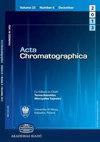Optimization of excitation and emission wavelengths for the UHPLC fluorescence detector for priority polycyclic aromatic hydrocarbons (PAHs)
IF 1.7
4区 化学
Q3 CHEMISTRY, ANALYTICAL
引用次数: 0
Abstract
Polycyclic aromatic hydrocarbons (PAHs) are persistent organic pollutants (POPs) that are widely distributed in the environment and cause significant environmental damage. Furthermore, they endanger human health by polluting food from the natural environment and food processing. Therefore, it is necessary to accurately detect PAHs in various sample matrices, which requires precise, practical, and rapid detection methods. The purpose of this research is to develop a high sensitivity analysis method by analyzing the optimum excitation and emission wavelengths of EPA's 15 priority polyaromatic hydrocarbons in the UHPLC fluorescence detector (Acenaphthene, Anthracene, Benzo[a]anthracene, Benzo[b]fluoranthene, Benzo[k]fluoranthene, Benzo[ghi]perylene, Benzo[a]pyrene, Chrysene, Dibenzo[a,h]anthracene, Fluoranthene, Fluorene, Indeno[1,2,3-cd]pyrene, Naphthalene, Phenanthrene, and Pyrene). An average of 17–25 analyses were performed for each polyaromatic hydrocarbon, and optimized excitation and emission wavelengths were obtained. LOD levels between 2 and 90 ppt were obtained with the method created in this direction. It is worth mentioning that the limits achieved for some PAH parameters are lower than those reported in the literature after pre-concentration steps.优先多环芳烃(PAHs) UHPLC荧光检测器激发和发射波长的优化
多环芳烃是一种持久性有机污染物,广泛分布于环境中,对环境造成严重破坏。此外,它们通过污染自然环境和食品加工中的食品,危害人类健康。因此,有必要准确检测各种样品基质中的多环芳烃,这需要精确、实用、快速的检测方法。本研究的目的是通过分析UHPLC荧光检测器中EPA的15种优先多环芳烃(环烷烃、蒽、苯并[a]蒽、苯并[b]荧蒽、苯联[k]荧、苯并[ghi]苝、苯并[a]芘、Chrysene、二苯并[a,h])的最佳激发和发射波长,开发一种高灵敏度分析方法蒽、荧蒽、芴、茚[1,2,3-cd]芘、萘、菲和芘)。对每种多环芳烃平均进行了17-25次分析,并获得了优化的激发和发射波长。LOD水平介于2和90之间 ppt是用这个方向创建的方法获得的。值得一提的是,一些PAH参数在预浓缩步骤后达到的极限低于文献中报道的极限。
本文章由计算机程序翻译,如有差异,请以英文原文为准。
求助全文
约1分钟内获得全文
求助全文
来源期刊

Acta Chromatographica
化学-分析化学
CiteScore
4.00
自引率
0.00%
发文量
55
审稿时长
2.3 months
期刊介绍:
Acta Chromatographica
Open Access
Acta Chromatographica publishes peer-reviewed scientific articles on every field of chromatography, including theory of chromatography; progress in synthesis and characterization of new stationary phases; chromatography of organic, inorganic and complex compounds; enantioseparation and chromatography of chiral compounds; applications of chromatography in biology, pharmacy, medicine, and food analysis; environmental applications of chromatography; analytical and physico-chemical aspects of sample preparation for chromatography; hyphenated and combined techniques; chemometrics and its applications in separation science.
 求助内容:
求助内容: 应助结果提醒方式:
应助结果提醒方式:


